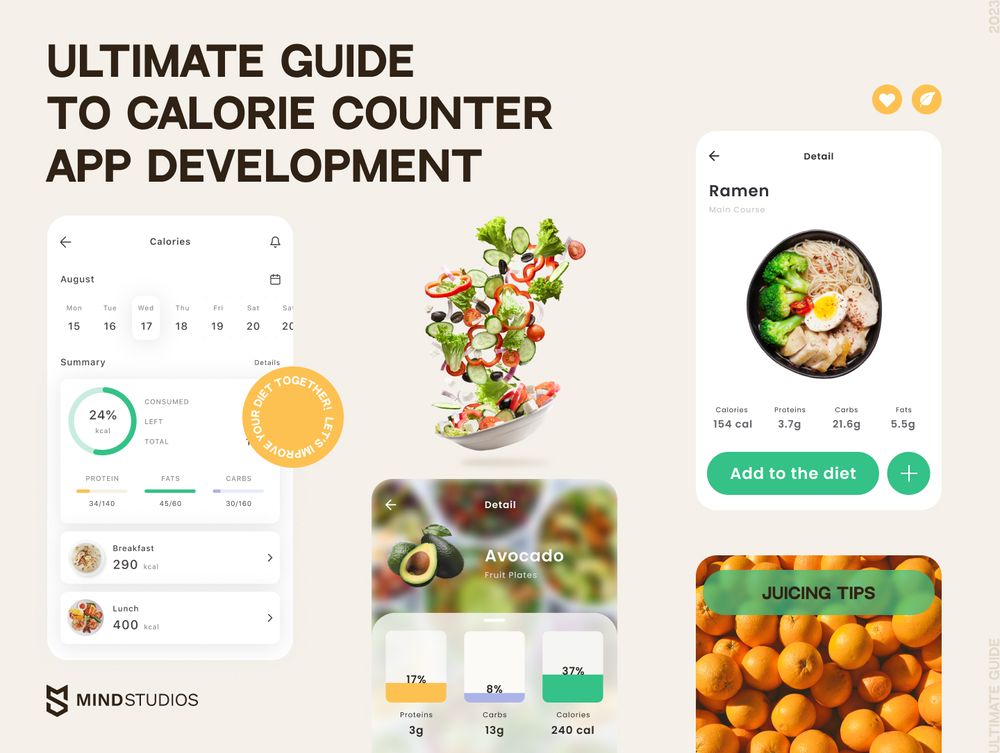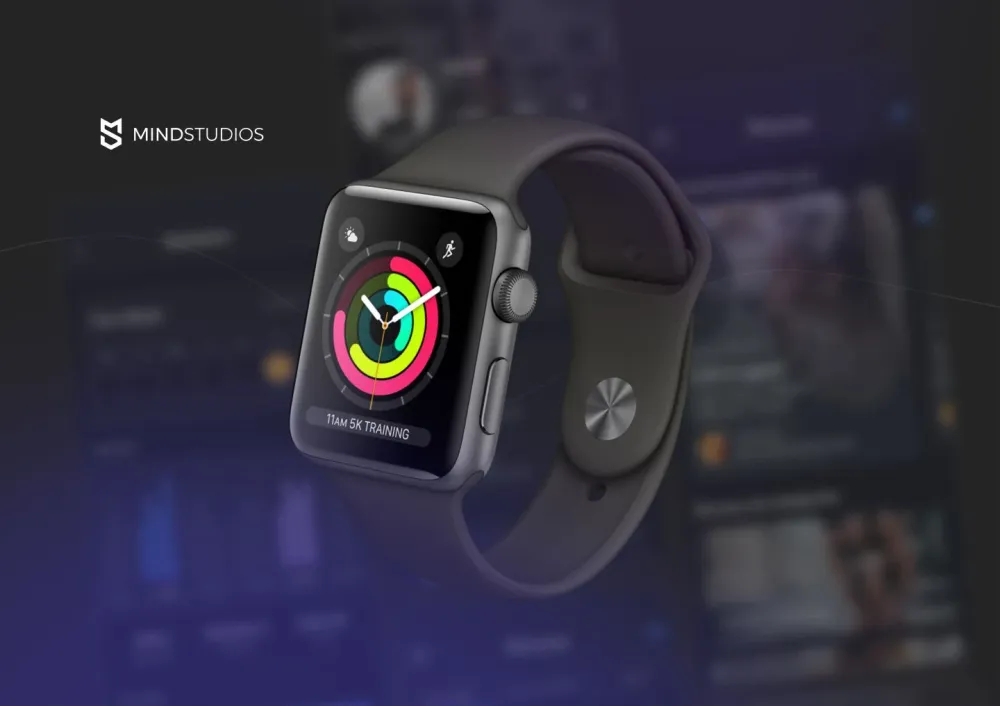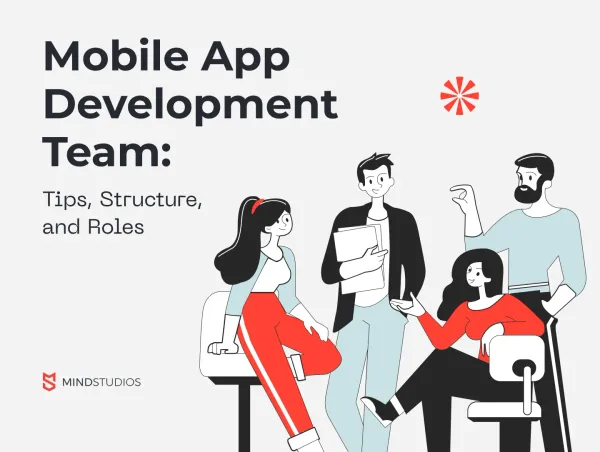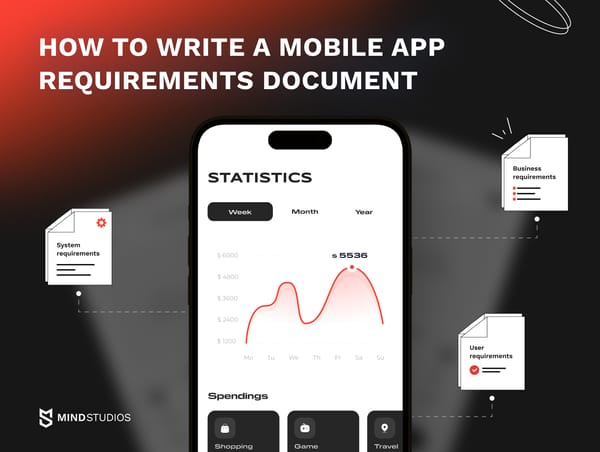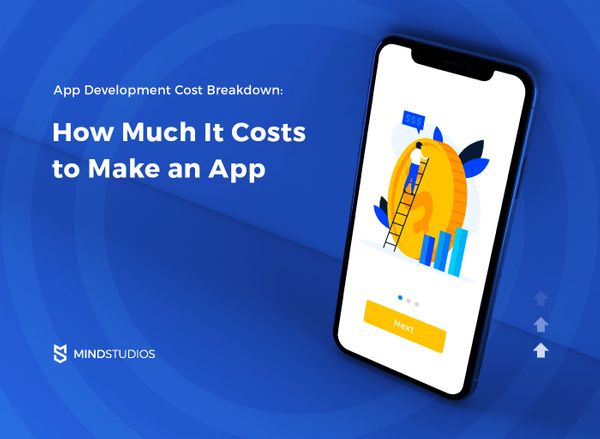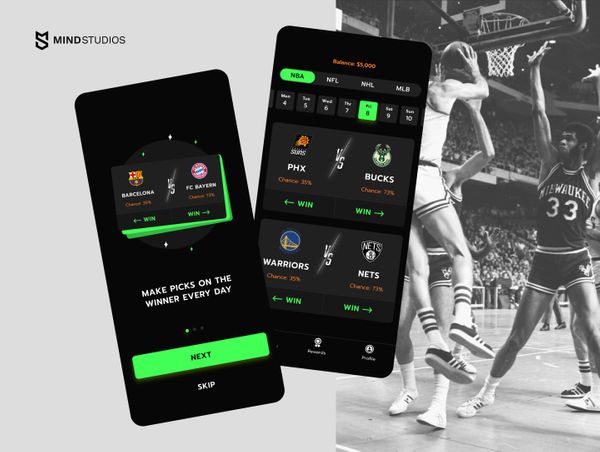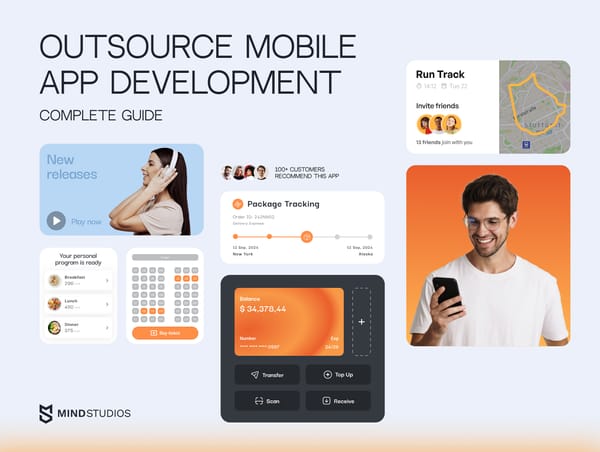The combination of wearable devices and fitness applications has transformed how we track and monitor our fitness activity. Wearable app development for fitness trackers and smartwatches involves creating features that enhance performance and deliver a seamless, personalized experience when integrated with fitness applications. The fitness app market, in particular, is rapidly expanding.
In this article, we will look at how wearable integration improves fitness app performance and user experience. We will also highlight the best practices of wearable app development.
We address all aspects of developing apps for wearable devices with an eye toward innovation. You have found the right place if you need an all-inclusive wearable app that your clients will love. Read on for more about what goes into development, or contact our experts for a no-cost consultation if you'd like some advice on a planned or existing project.
Understanding fitness wearable technology
The increased awareness of health and well-being has resulted in an increase in wearable fitness trackers that provide real-time data on heart rate, sleep habits, calorie consumption, and exercise performance. Integration with smartphone applications, GPS tracking, blood pressure monitoring, and activity detection have all improved the accuracy and utility of these devices.
As the global recognition of chronic diseases such as obesity, diabetes, and cardiovascular disease as acute problems rises, wearable fitness trackers serve as proactive monitoring devices, assisting people in tracking vital signs, setting goals, and changing behavior to decrease these risks. The use of AI and ML technologies, on the other hand, has enhanced the functionality of these gadgets, delivering personalized recommendations and insights into users' fitness behaviors.
Types of wearable applications
Wearable technology is electronic gadgets worn or implanted in the body that link to smartphones or other devices via the internet or Bluetooth. These gadgets capture data and share it with other connected devices, making them ideal for various applications in healthcare, gaming, fashion, fitness, and other industries. They are becoming increasingly popular, and from an estimated value of $55.5 billion in late 2022 to $142.4 billion in 2030, the wearable technology industry is expected to expand at a CAGR of about 12.5% from 2024 to 2030.
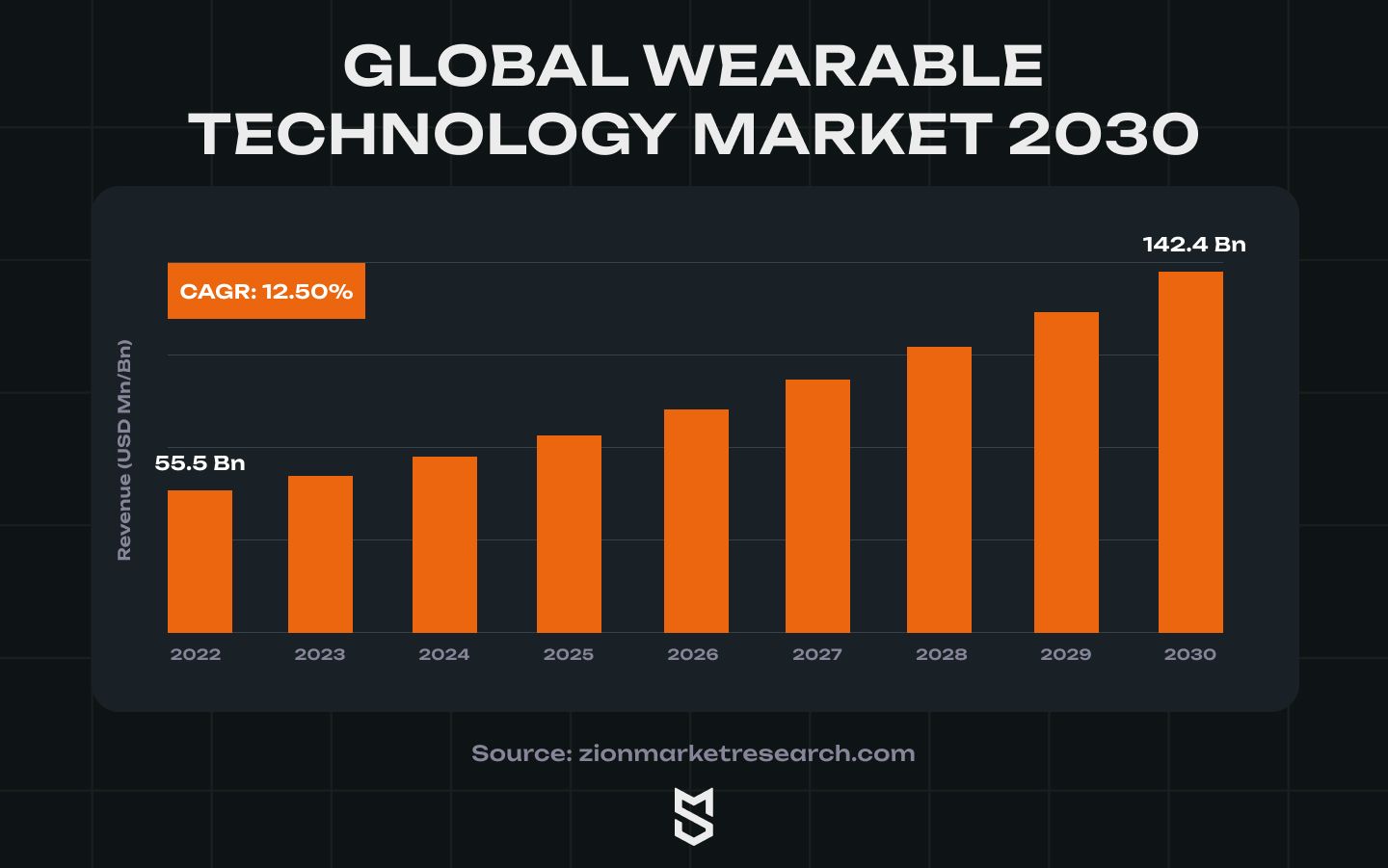
That said, wearable tech alone is nothing without proper software. Multiple types of apps are usually associated with smart tracking tech, including but not limited to the following:
- Workout apps provide users with exercise regimens and plans for reaching various fitness goals, including weight loss, muscle building, and endurance training. They can also contain video demonstrations, timers, and progress tracking. Fiit, a fitness app, is a great example of a well-designed workout program.
- Nutrition and diet applications can be helpful to those who want to manage their daily calorie consumption, monitor their macronutrient ratios, and get meal plans and recipes for a balanced diet. Apps like YAZIO even allow users to engage in challenges to boost motivation.
- Activity-tracking apps track daily activity levels such as steps taken, distance traveled, and calories burned using smartphone sensors and wearable devices. Although several fitness applications have the capability, one of the most popular is the iOS Health app.
- Guided meditation and yoga practices, mindfulness exercises, and relaxation techniques are available through yoga and meditation apps to reduce stress and increase mental well-being. Calm and Envol are two wonderful examples of offering individual and company plans.
- Running applications measure distance, speed, and time. They offer training schedules and audio coaching to help users achieve their running goals. To get an idea, look at Strava.
- Apps for virtual fitness courses provide access to live and pre-recorded exercise classes in various forms, including dance, barre, and Pilates. Fitr, and Nike Training Club provide a wealth of home workouts and a personalized touch for everyone.
- Wellness and health apps provide comprehensive approaches to health and wellness, including features such as sleep tracking, stress management, and habit tracking. Among the various types of wearable apps, heart rate tracking apps are particularly popular for their ability to provide real-time heart rate data, helping users maintain optimal fitness levels and monitor their health. The Envol and BetterSleep apps, for example, can help users improve their mindfulness state and develop healthy sleeping habits.
Wearable devices app development process step-by-step
Wearable app development includes several important steps to help you create a fully functional app. The following are the key components to developing a successful app for wearable devices:
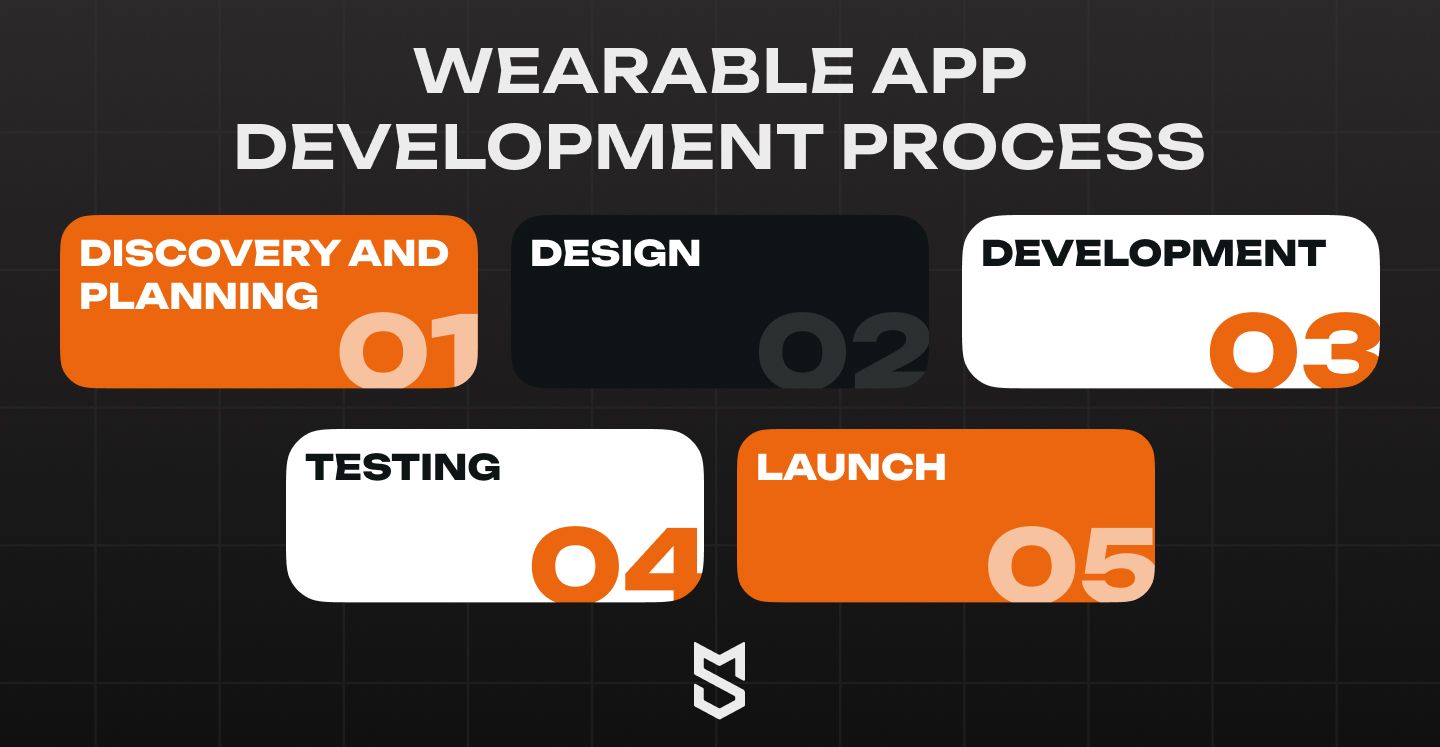
Discovery and planning
At the end of this stage, you should have a clear vision for your wearable app. You must comprehend what tasks users will accomplish with your app and how they interact. To make wearable apps, it’s crucial to specify how the app will be connected to smartphones, watches, smart glasses, or other smart devices.
Design
Designers will produce interface prototypes or wireframes based on your specifications. Even though certain challenges may arise due to small screens of wearable devices, it's important to ensure the interface allows users to communicate with your program and complete the assigned tasks.
Development
This stage involves numerous coding operations. Following design management is the pinnacle of development art. It is time to put UI/UX design into action by utilizing code. At this stage, depending on the type of wearable software you're developing, you'll require a team of expert native and cross-platform developers.
Backend, frontend, and API integrations are the three main parts of an app's development process. In an outsourcing company like Mind Studios, after deciding on the tech stack, your project will be assigned to developers skilled with selected technologies.
To ensure the design is compatible with the codebase, developers need an in-depth understanding of the entire project. The frontend and backend teams collaborate closely to accomplish this shared goal.
Developers typically utilize programming languages like Swift, Kotlin, and Java to create a wearable device app. Regarding frameworks, watchOS and WearOS are two of the most popular options for smartwatches and fitness trackers.
Testing
This is a critical stage in creating any Apple Watch software or Android wear app. The initial tests are frequently carried out concurrently with development. The development team must detect and solve all bugs before deploying the app. It is critical to test the app's interoperability with various devices and the accuracy of data exchange with smartphones while developing wearable apps.
Launch
When everything has been thoroughly validated, the application can be made public. Apps for wearables are typically distributed through app marketplaces. Your solution must meet the platform's requirements to be approved and published on an app store. We also advise paying close attention to your app's description in stores and techniques to promote it through various channels to ensure maximum visibility among your target audience.
Best features to include in a wearable fitness app
Integrating health and fitness tracking features significantly improve fitness app performance by providing precise data recording, real-time feedback, personalized recommendations, sleep analysis, social integration, health monitoring, continuous progress tracking, and smart home fitness equipment integration.
These innovations enable users to optimize their workout regimens more effectively, track their progress, stay inspired, and achieve their goals. Fitness apps integrated with wearables provide a comprehensive and personalized fitness experience beyond typical tracking and monitoring.
Developing a successful fitness tracker app requires careful consideration of the features that users find useful and necessary in their fitness journeys. The following are the essential features of a fitness tracker app:
| Feature | How does it improve the app? |
|---|---|
| Activity tracking | Tracking physical activities like walking, running, cycling, swimming, and workouts via GPS |
| Heart rate monitoring | Integrating functionality to track the user's heart rate during various activities and at rest |
| A calorie counter | Providing a food database that will track meals and calories to help users balance their energy intake and expenditure |
| Sleep tracker | Analyzing sleep patterns to provide information about sleep quality, duration, and patterns |
| Goal-getting | Assisting users to set fitness goals like weight loss, muscle gain, or specific activity targets. Sending reminders and notifications to keep them motivated |
| Progress tracking | Allowing users to monitor their progress, including weight loss, steps taken, distance traveled, and other relevant metrics |
| Workout plans | Providing pre-designed workout plans for various fitness levels and goals with detailed instructions, videos, and progress tracking for each exercise |
| Community features | Allowing users to connect, share accomplishments, and motivate one another via leaderboards, challenges, and group activities |
| Wearable device integration | Allowing seamless data syncing with popular wearable devices such as smartwatches and fitness bands |
| Water intake tracker | Providing functionality to monitor daily water intake and reminding users to stay hydrated throughout the day |
| Health app integration | Integrating with other apps and devices for a comprehensive overview of users' health, including data from sensors and other health-related apps |
| Customization | Allowing users to personalize their experience by selecting preferred metrics, themes, and notification settings |
| Expert advice | Offering personalized advice and guidance from fitness experts, nutritionists, or trainers within the app |
| Interactive features | Providing regular feedback and analysis of users' activities and progress, offering insights and suggestions for improvement |
| Offline functionality | Offering basic functionality even when the user is not connected to the internet, syncing data once the connection is restored |
| In-app challenges | Allowing users to create fitness challenges within the app, encouraging them to compete and reach specific goals |
| Mindfulness and stress management | Implementing mindfulness exercises, meditation, or stress-relief activities to promote overall well-being. |
| Accessibility | Integrating features like voice commands and screen reader compatibility for users with disabilities |
Development best practices
When it comes to developing wearable apps, there are several key considerations to keep in mind. First and foremost, selecting the right platform is crucial. Whether it's watchOS for Apple Watch, Wear OS for Android-based devices, or proprietary platforms like Fitbit OS or Garmin Connect IQ, choosing the platform that aligns with your app's goals is essential. There are also other practices that you can follow to ensure the success of your wearable health or fitness app. Here are some of the best practices we suggest exploring:
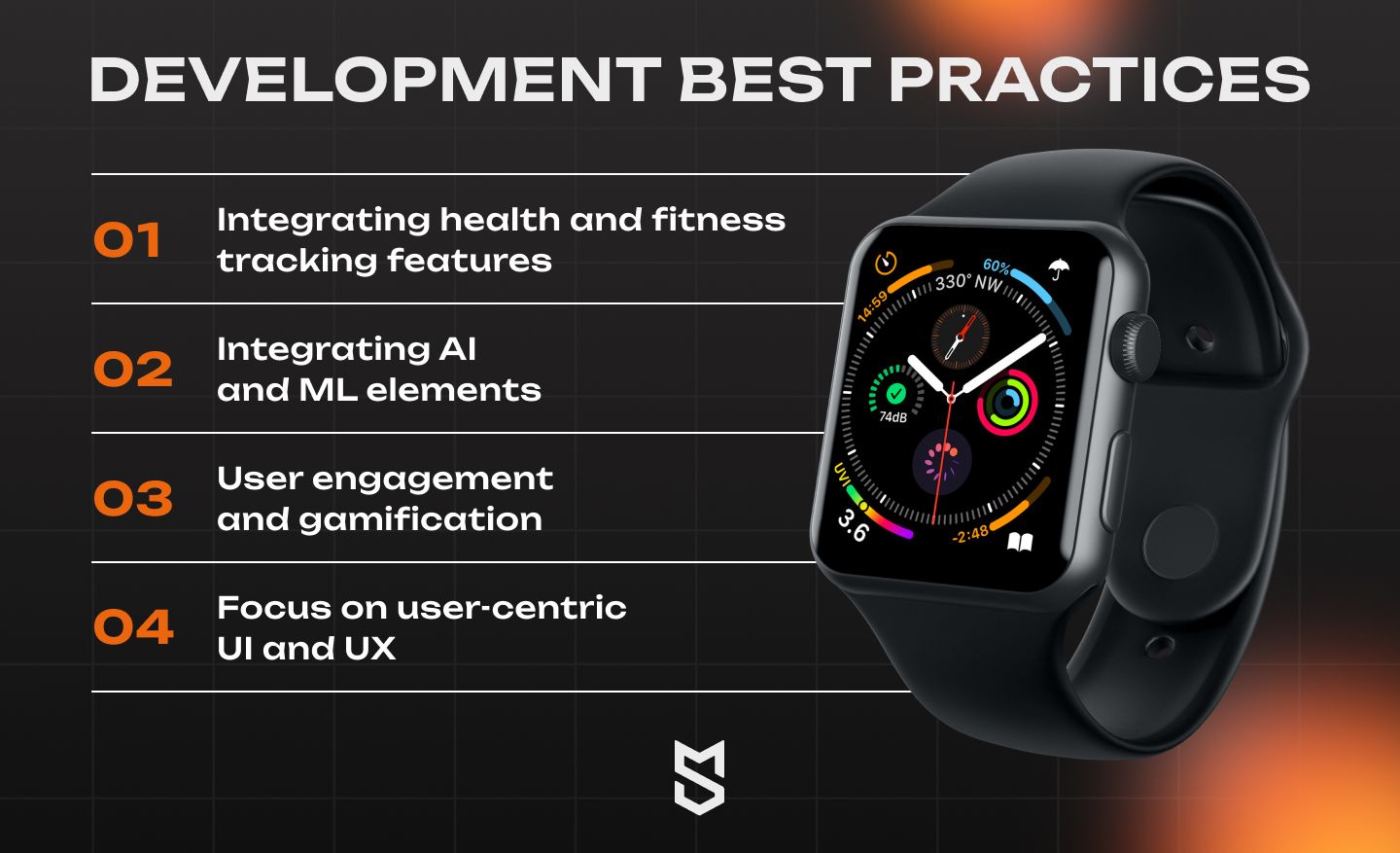
User feedback and testing
Incorporating user testing before launch guarantees that your fitness software satisfies user expectations and that all features, whether paid or not, perform effectively. You wouldn't want to offer users a feature that only works half the time. At this stage, you can run focus groups, beta tests, and other analytics tools to collect and analyze user feedback.
Integrating AI and ML elements
Integrating artificial intelligence (AI) and machine learning (ML) algorithms is one of the current developments in the fitness app market. These technologies allow apps to deliver highly tailored recommendations while adapting to changing user needs. AI systems, for example, can assess users' workout data and recommend alterations to improve their performance or prevent injuries.
User engagement and gamification
Another thing you should focus on is the gamification of fitness apps, which reward users for meeting fitness goals or completing tasks. This adds a fun and motivational component to the app, keeping users interested and committed to their fitness path. Gamification features such as virtual badges, leaderboards, and social sharing opportunities may be included to stimulate friendly rivalry among users.
Fitness apps combine social aspects, AI, and gamification to build a sense of community. Users can utilize these capabilities to connect with friends, participate in virtual fitness contests, and share their accomplishments on social media platforms. Fitness applications enable users to stay motivated and accountable by providing a friendly and interactive atmosphere.
Focus on user-centric UI and UX
Designing user interfaces for wearables requires thoughtful consideration due to the small screen size and limited interaction capabilities. Keep the interface intuitive, glanceable, and focused on delivering essential information quickly. Minimalist design principles, clear typography, and leveraging gestures, voice commands, and haptic feedback can optimize the user experience. Finally, identifying your wearable app's core features and functionalities is crucial. Prioritize features that align with your app's purpose and deliver tangible value to the user.
Monetization strategies for fitness wearable apps
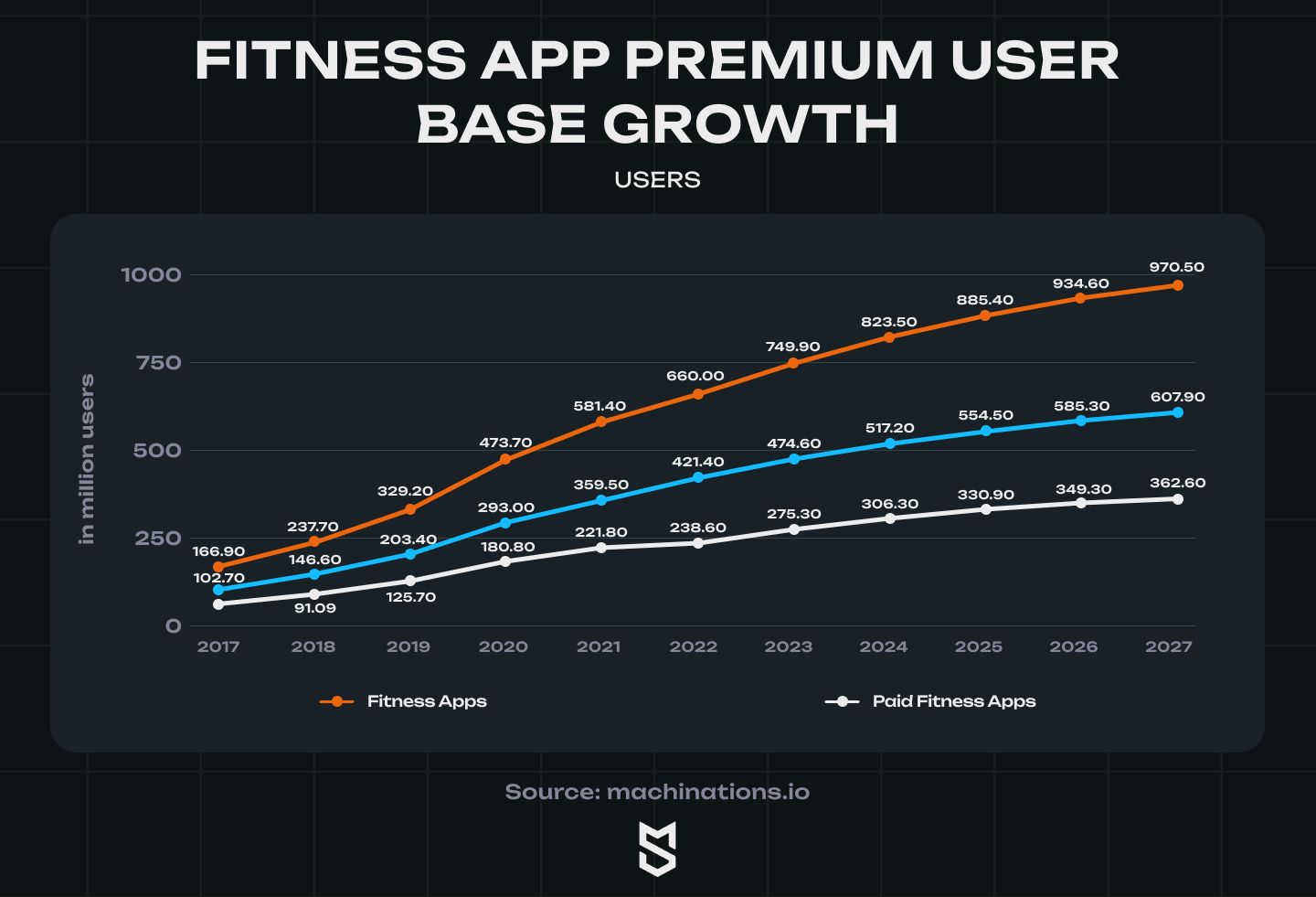
[Source: Statista]
According to Statista, the user bases of premium and free fitness apps have grown in lockstep since 2017 and are predicted to reach 970 million active users by 2027. Choosing the best monetization approach, such as in-app purchases, subscriptions, or advertisements, comes at a cost. Implementing these capabilities involves meticulous preparation and, in some cases, extra payment gateway integrations. Premium subscription is a great way to monetize an app for wearables, but it’s not the only one.
Here are some great fitness app monetization strategies:
Monetization strategy |
How it works |
|---|---|
Freemium business model |
Freemium: Provide basic services such as physical activity tracking and simple workouts for free to attract users. Premium services: Offer additional services like individualized fitness routines, nutritional advice, and detailed analytics for a fee. |
Subscription plans |
Subscription levels: Offer various subscription plans with different features and durations. Premium subscribers: Provide premium subscribers with special fitness routines, live classes, or expert guidance. |
In-app purchases |
Virtual goods: Sell virtual objects like badges, achievements, or fitness equipment skins for user personalization. Additional workouts: Offer unique workout packs or training modules as one-time purchases. |
Affiliate marketing |
Product recommendations: Earn commissions by recommending exercise equipment, vitamins, or apparel within the app. Collaborations: Partner with fitness brands for unique offers, earning a fee on sales through your recommendations. |
Monetization through advertising |
Banner ads: Place banner advertisements at the bottom of the app's UI. Video ads: Display short video advertisements between training sessions or when users access specific services. Rewarded ads: Provide incentives like extended workouts or premium features in exchange for watching ads. |
Corporate collaborations |
Corporate wellness programs: Collaborate with companies to include your app in employee wellness efforts for a corporate fee. Brand collaborations: Collaborate with sponsors for sponsored fitness challenges promoting their products or services in the app. |
Monetization of data (ethical and secure) |
Aggregate data monetization: Aggregate and sell anonymized user data to fitness researchers or businesses interested in health trends. Market research surveys: Incentivize users to participate in market research surveys conducted within the app. Partnerships with healthcare providers: Work with healthcare practitioners for virtual consultations or telehealth services, charging users per session. Integration fees: Charge fees to healthcare providers or insurance organizations to connect their services to your app. |
If you would like to know more about how to get funding for an app, read our guide here.
Future trends in wearable app development
Since technology has emerged as a driving force worldwide, it has set human minds and skills to automate processes and improve user experiences across many industries and sectors. App development is contributing significantly to this by accelerating industrial growth. Wearable technology is a future-oriented app development strategy gaining traction from every mobile and smartwatch app development company amid this expansion.
Although wearable technology is not new, it has begun to change app development trends and versatility to provide maximum performance. The following are some of the dominant trends in wearable app development:
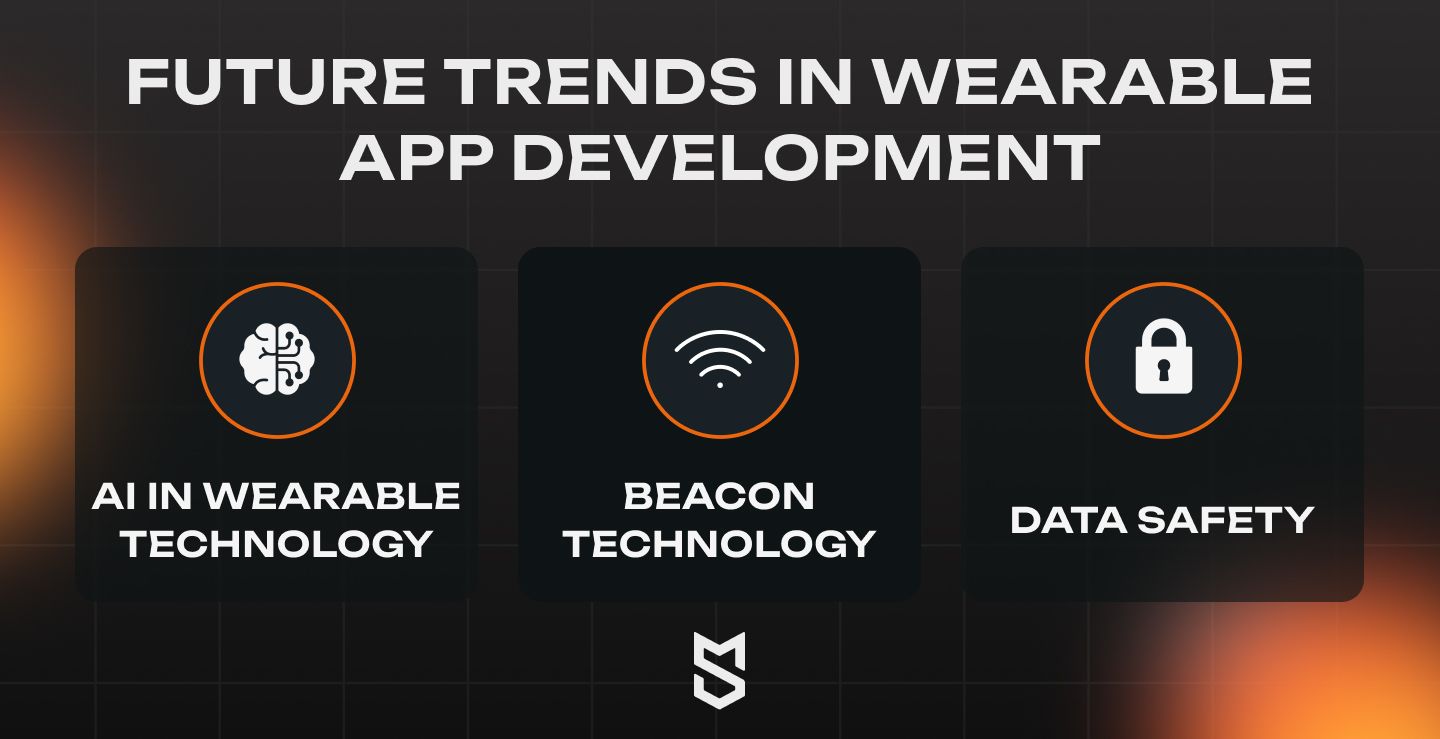
AI in wearable technology
AI has greatly impacted the app development and business industries, providing quick, automated solutions and enhancing service quality. Sensor technology has been widely used in developing wearable apps, allowing for unique functions, personalized services, and data provision. For example, this technology has enabled heartbeat counts, blood pressure monitoring, and calorie intake tracking in the healthcare industry. Sensor technology is used in fitness-tracking wearable devices to track pulse rates and daily steps, while AI helps analyze the data collected by sensors.
Beacon technology
Beacon technology, which uses low-energy Bluetooth transmitters, provides effective connectivity with neighboring electronic devices for location-based searches. This technology has been widely used in the production of smartwatches and is predicted to increase further in 2024. Beacon technology provides more advanced and exact results than GPS services, making it an appealing option for mobile app development firms.
Data safety
Wearable app development should contain data security measures to safeguard data integrity and user privacy. Data safety measures are necessary because some data in fitness apps might be sensitive, like chronic health conditions or users' personally identifiable data that can be used for identity theft. Wearable app developers can avoid unsafe scenarios and provide the best possible performance for their customers by assessing and filtering suspicious or improbable data.
Compliance with health data requirements, app store guidelines, and intellectual property restrictions all increase the development cost. Legal advice and administrative support are critical, especially for wellness apps dealing with sensitive data
Mind Studios as your wearable app development partner
Wearable technology and fitness applications are not new to Mind Studios. With our background in the healthcare and fitness industries, we know firsthand how challenging it can be to stand out in a crowded marketplace. Here is just one of many fitness-related projects we helped develop.
Fitr
Fitr is a platform designed to simplify the lives of fitness coaches and their remote clients. Coaches using it have one place to go for all of their program, financial, and client communication needs.
As a coach, you can use the platform's resources to grow your client base, automate payments and training regimens, and let participants compete without meeting in person. Client and program administration, communication tools, and integrated payments are just a few features it offers to meet the needs of brands, athletes, and coaches.
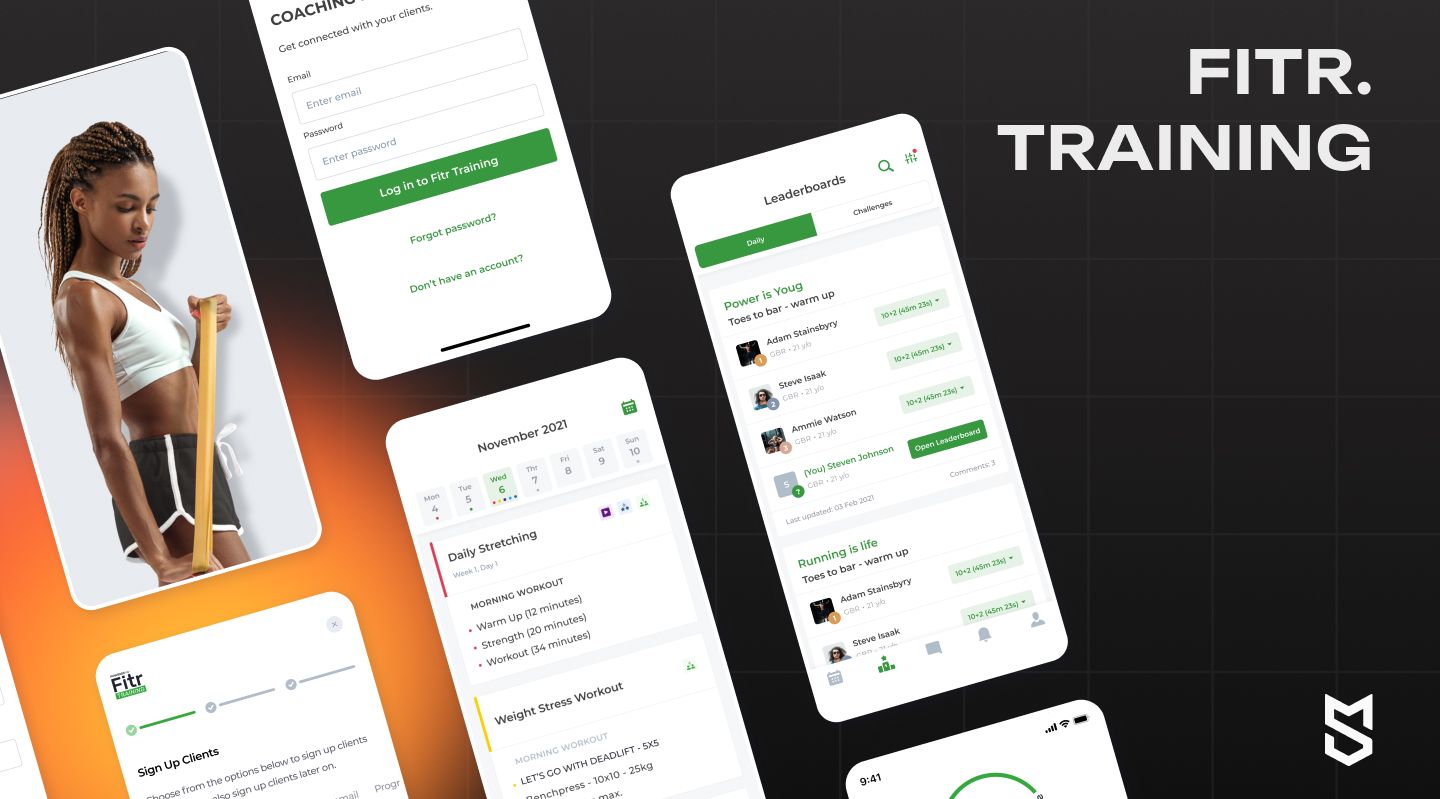
Fitr was originally developed as a smartphone app, training has since moved to a web platform to accommodate instructors' demands. Athletes subsequently had a mobile app built for them. The platform's designers prioritized the interface's ease of use and aesthetics.
Following a successful launch and continuous tweaks to enhance conversion rates, the platform received positive feedback. The platform has been continuously enhanced thanks to the team's close collaboration with clients and the fitness community, who have provided valuable input.
While Fitr is a mobile app, Mind Studios has experience working with IoT devices and wearables. This expertise, combined with our experience in fitness app development, enables us to create wearable apps that exceed user expectations.
If you would like to learn more about the project, check out our case study.
Conclusion
Fitness apps that work with wearable devices have completely changed the game regarding keeping tabs on our exercise routines. These gadgets provide personalized suggestions and insights into customers' fitness practices, which can now be augmented using AI and ML technologies. Sports, gaming, and even the fashion industry are just a few potential uses for wearable devices like fitness trackers and smartwatches.
Discovering and planning, designing, developing, testing, and launching are all essential to creating a wearable app today. To ensure the wearable app is successful, picking the correct platform and sticking to best practices is crucial.
While it's great to have a general notion of where to begin, getting professional advice can help you get your project lifted off more quickly. Contact our specialists at Mind Studios for a free consultation if you're looking for guidance on developing your wearable app idea effectively or looking for ways to monetize an existing app.

